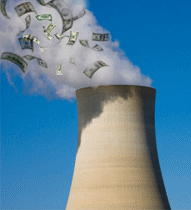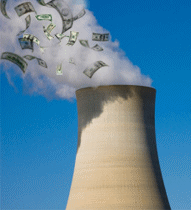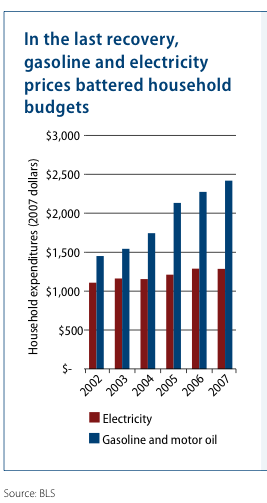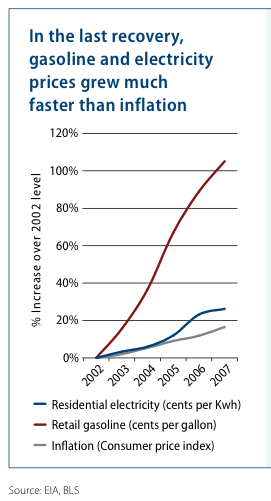The Republican proposal, drafted by a group led by Representative Mike Pence of Indiana, leans heavily on nuclear power, setting a goal of building 100 reactors over the next 20 years.
The GOP energy proposal, the American Energy Act (AEA), is nothing more than a good old-fashioned energy tax on consumers. The House energy and climate bill, on the other hand could save $3,900 per household by 2030, thanks to its strong emphasis on energy efficiency, which is utterly absent from the GOP plan.
 The cornerstone of the GOP plan — whose acronym just happens to be nearly identical to that of the IAEA (International Atomic Energy Agency) — is an $800 billion plan to build 100 nukes (see “Areva has acknowledged that the cost of a new reactor today would be as much as 6 billion euros, or $8 billion, double the price offered to the Finns”). Taxpayers will assume the full liability for any default on those nuclear plants. The Congressional Budget Office estimates the likely default rate of these loans at over 50% — so that’s $400 billion down the toilet right there. And of course taxpayers already assume the liability for any catastrophic meltdown.
The cornerstone of the GOP plan — whose acronym just happens to be nearly identical to that of the IAEA (International Atomic Energy Agency) — is an $800 billion plan to build 100 nukes (see “Areva has acknowledged that the cost of a new reactor today would be as much as 6 billion euros, or $8 billion, double the price offered to the Finns”). Taxpayers will assume the full liability for any default on those nuclear plants. The Congressional Budget Office estimates the likely default rate of these loans at over 50% — so that’s $400 billion down the toilet right there. And of course taxpayers already assume the liability for any catastrophic meltdown.
Now we know that if you even start building a nuclear power plant, electricity bills go up a decade before any customer sees a single electron (see “What do you get when you buy a nuke? You get a lot of delays and rate increases….“ For customers of Progress Energy in Florida, which is trying to build twin nukes, bills jumped 25 percent in January “to cover early costs for the new reactors as well as increases in the cost of fuel Progress purchases to generate power.”
By spreading 100 nukes around the country and with no strategy to stop fuel prices for power generation from rising, the GOP plan would be the equivalent of a 25% tax on every American’s electricity bill.
But that’s not all.
The Atomic Energy Agency American Energy Act is “Identical To President Bush’s Failed Plan” as Media Matters demonstrates with a side-by-side comparison between AEA and the Cheney plan. In April, the Center for American Progress (CAP) released a detailed analysis showing the main result of the Bush-Cheney plan was that energy costs rose more than $1,100 for the average American household:
Over this period, the typical annual American household expenditure on electricity rose more than $170, and the typical annual American expenditure on gasoline rose more than $960 (in 2007 dollars). Note that the gasoline price increases listed here do not include the unprecedented $147 per barrel of oil and $4.11 gasoline prices that occurred in the summer of 2008.
The new GOP plan is not just a 25% tax on electricity. Since it does nothing whatsoever to deal with our dangerous and growing dependence on oil — whose global production is at or near the peak — it will inevitably lead to the same exact outcome that the Cheney-Bush plan did, a sharp rise in consumer fuel prices, the equivalent of a huge gasoline tax (except the “revenues” of this tax end up in the hands of OPEC).
The GOPs costly national energy tax plan is actually quite similar to the energy plan Joe Barton (R-TX) offered a while back (see “Contempt of Congress: House GOP reveals disdain for clean energy, livable climate with a more-of-the-same rehash of Cheney energy plan“)? It still stops the EPA from taking any action whatsoever on global warming. And yet, as you may remember, the GOP leadership dissed the Barton plan, as the Politico noted in a piece, “Leaders cool on warming skeptic“:
Republican leaders aren’t backing a Barton alternative to the Waxman-Markey bill that would gut the 1990 Clean Air Act to prevent the Environmental Protection Agency and other state agencies from regulating carbon emissions and other greenhouse gases as pollutants. Instead, they’re backing an alternative crafted by Indiana’s Pence — who’s not even on the Energy and Commerce panel — that seeks to expand nuclear energy production, improve clean coal technology and “drill, baby, drill” for oil and gas in this country.
Thankfully, this GOP plan exists only for the purpose of giving the party some talking points, although why 100 nukes and a national energy tax are positive talking points is a mystery to me.
Finally, since the GOP has seen fit to recycle the Cheney-Bush plan today, it seems only fair to recycle CAP’s analysis of its impact on US consumers:
America needs to invest in a diverse clean energy economy now instead of doubling down on dirty energy. The recession and the low prices of gasoline and electricity provide an opportunity to ensure the next period of economic growth is not like the last one.
Economic growth under Bush lasted from November 2001—when the United States emerged from the first Bush recession—to December 2007— the beginning of the second Bush recession, according to the National Bureau of Economic Research, which tracks and measures business cycles.
Over Bush’s period of economic growth, expenditures on electricity for a typical American family (earning the median income) grew 16 percent to $1,285 in 2007, up from $1,106 per year in 2002, an increase of $179. The typical family’s expenditure on gasoline grew nearly 70 percent to $2,418 in 2007, up from $1,450 in 2002, an increase of nearly $1000 (All dollar amounts in inflation-adjusted 2007 dollars.)
The price of gasoline and home electricity grew faster then general inflation because of the lack of diversity in our energy system and spiraling global demand for fossil fuels: 1.6 times faster in the case of residential electricity and a staggering 6.4 times faster in the case of gasoline.
These price spikes occurred despite the Bush administration’s massive public subsidies for dirty energy. The 2005 energy bill contained a token level of investment in renewable energy, but it also provided billions of dollars of support for dirty energy, offering $27 billion in subsidies for coal, oil, and nuclear energy.
Although the current recession has dragged down gas prices from the record $4.11 per gallon of July 2008, gas prices still averaged $2.01 in March 2009, up 67 percent from a $1.28 average in March of 2002. The fundamentals that created the huge increases in oil and electricity prices from 2002 through the summer of 2008—after the recession officially began but before demand plummeted worldwide—still lurk, and will return with a vengeance once the global economy begins to rebound.
Less economically-developed countries such as India and China are now entering a phase in their development where their energy demands are growing toward the levels of industrialized nations. What’s more, demand is on the rise as populations and economies grow worldwide. World energy consumption is expected to expand by 50 percent from 2005 levels by 2030. The global economic slowdown has only stalled these long-term trends that are contributing to a rise in oil, coal, natural gas and other fossil fuel prices.
We can ease the dirty energy burden on American families by investing in efficiency improvements, winning the race for clean 21st century energy, modernizing our electricity grid, requiring utilities to produce more renewable energy from the wind, sun, and other renewable sources, and mandating that utilities boost energy efficiency instead of pollution. We can make sure that, during the next recovery, American families have access to energy that’s cleaner and cheaper.




